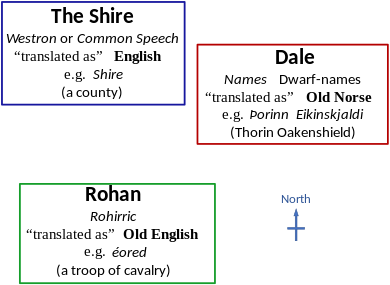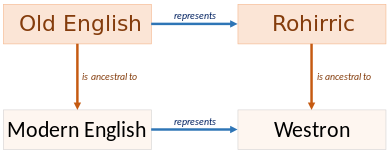| Revision as of 17:48, 16 October 2023 editAnas1712 (talk | contribs)Extended confirmed users34,649 editsNo edit summary← Previous edit | Revision as of 14:29, 18 June 2024 edit undoChiswick Chap (talk | contribs)Autopatrolled, Extended confirmed users, Page movers, New page reviewers, Pending changes reviewers, Rollbackers297,852 edits start, using materials from Languages constructed by J. R. R. Tolkien (see there for attrib.) and from the cited sourcesTag: Removed redirectNext edit → | ||
| Line 1: | Line 1: | ||
| '''Westron''' is the constructed language that was supposedly the Common Speech used in ]'s world of ] in the ], at the time of '']''. In practice in the novel, Westron is nearly always represented by modern English, in a process of ] which also sees ] represented by ]. That process allowed Tolkien not to develop Westron or Rohirric in any detail. In the Appendices of the novel, Tolkien gives some examples of Westron words. | |||
| #REDIRECT ] | |||
| == Linguistic mapping == | |||
| {{Rcat shell| | |||
| {{R ME to section}} | |||
| {{further|Pseudotranslation in The Lord of the Rings}} | |||
| {{R from merge}} | |||
| {{R with Wikidata item}} | |||
| ], Tolkien invented parts of ] to resolve the linguistic puzzle he had accidentally created by using three different ] European languages for those of peoples in his legendarium.{{sfn|Shippey|2005|pp=131-133}}]] | |||
| {{DEFAULTSORT:westron}} | |||
| }} | |||
| When writing '']'' (1954–55), a sequel to '']'' (1937), Tolkien came up with the literary device of using real languages to "translate" fictional languages. He pretended to have translated the original language Westron (named ''Adûni'' in Westron) or Common Speech (''Sôval Phârë'', in Westron) into English. This device of rendering an ''imaginary'' language with a ''real'' one was carried further by rendering:{{sfn|Shippey|2005|pp=131-133}} | |||
| * Rohirric, the language of ] (related to Westron) by the ] of ]{{sfn|Shippey|2005|pp=131-133}} | |||
| * names in the tongue of ] by ] forms{{sfn|Shippey|2005|pp=131-133}} | |||
| * names of the ] by ] forms, thus mapping the genetic relation of his fictional languages on to the existing historical relations of the ].{{sfn|Shippey|2005|pp=131-133}} | |||
| The whole device of linguistic mapping was essentially a fix for the problems Tolkien had created for himself by using real Norse names for the Dwarves in '']'', rather than inventing new names in Khuzdul. This seemed a clever solution, as it allowed him to explain the book's use of Modern English as representing Westron.{{sfn|Fimi|2010|pp=189–191}} Because of this, Tolkien did not need to work out the details of Westron grammar or vocabulary in any detail.{{sfn|Hemmi|2010|pp=147–174}} | |||
| ] to Modern English is like the mapping of Rohirric to Westron, and Tolkien uses the two Germanic languages to represent the two Middle-earth languages.<ref name="Tolkien Rohanese" group=T>{{harvnb|Tolkien|2001|p=8}}</ref>]] | |||
| == Language == | |||
| Westron (also called Adûni) supposedly developed from ], the ancient language of ].<ref name="Sauron Defeated" group=T>{{harvnb|Tolkien|1992|pp=241, 247–250, 413–440}}</ref> It became the ] for all the peoples of ]:{{sfn|Solopova|2009|pp=70, 84}} Tolkien gives some examples of Westron words in Appendix F to ''The Lord of the Rings'', where he summarizes Westron's origin and role as '']'' in Middle-earth:<ref name="Appendix F" group=T/> | |||
| {{blockquote|The language represented in this history by English was the Westron or 'Common Speech' of the West-lands of Middle-earth in the Third Age. In the course of that age it had become the native language of nearly all the speaking-peoples (save the Elves) who dwelt within the bounds of the old kingdoms of Arnor and Gondor ... At the time of the War of the Ring at the end of the age these were still its bounds as a native tongue.<ref name="Appendix F" group=T>{{harvnb|Tolkien|1955}}, Appendix F</ref>}} | |||
| He explains further that | |||
| {{blockquote|the Númenóreans had maintained ... havens upon the western coasts of Middle-earth for the help of their ships; and one of the chief of these was at Pelargir near the Mouths of Anduin. There Adûnaic was spoken, and mingled with many words of the languages of lesser men it became a Common Speech that spread thence along the coasts among all that had dealings with Westernesse.<ref name="Appendix F" group=T/>}} | |||
| Tolkien gives a few names in Westron, saying that ''Karningul'' was the translation of Elvish ''Imladris'', ], while ''Sûza'' was Westron for ]. Hobbit surnames Took and Boffin were "anglicize" from Westron ''Tûk'' and ''Bophîn''.<ref name="Appendix F" group=T/> He explains, too, that ]] and Ham "were really called ''Ban'' and ''Ran''", shortened from Westron ''Banazîr'' and ''Ranugad''.<ref name="Appendix F" group=T/> Tolkien states that these had been nicknames, meaning "halfwise, simple" and "stay-at-home", which he had chosen to render by English names, from Old English ''samwís'' and ''hámfoest'' with equivalent meanings.<ref name="Appendix F" group=T/> The word ], which the narrator admits "is an invention", could easily be a much-worn form of the Old English ''holbytla'', "hole-dweller". This corresponds to the Westron dialect form ''kuduk'', used in ] and the Shire, which the narrator supposes was probably a worn form of the word ''kûd-dûkan'', of the same meaning, stating that Merry had heard King ] of Rohan use this name for Hobbit.<ref name="Appendix F" group=T/> | |||
| == References == | |||
| === Primary === | |||
| {{reflist|group=T|30em}} | |||
| === Secondary === | |||
| {{reflist}} | |||
| == Sources == | |||
| * {{cite book |last=Fimi |first=Dimitra |author-link=Dimitra Fimi |title=Tolkien, Race, and Cultural History: From Fairies to Hobbits |publisher=] |year=2010 |orig-year=2008 |isbn=978-0-230-21951-9 |oclc=222251097}} | |||
| * {{cite journal |last=Hemmi |first=Yoko |title=Tolkien's The Lord of the Rings and His Concept of Native Language: Sindarin and British-Welsh |journal=] |volume=7 |year=2010 |pages=147–174 |doi=10.1353/tks.0.0063 |s2cid=170366632 |via=] |url=https://doi.org/10.1353/tks.0.0063}} | |||
| * {{ME-ref|ROAD}} <!--Shippey 2005--> | |||
| * {{ME-ref|Solopova}} <!--Solopova 2009--> | |||
| * {{ME-ref|ROTK}} <!--Tolkien 1955--> | |||
| * {{ME-ref|SD}} <!--Tolkien 1992--> | |||
| * {{cite journal |last=Tolkien |first=J. R. R. |author-link=J. R. R. Tolkien |title=The Rivers and Beacon-hills of Gondor |editor-last=Hostetter |editor-first=Carl F. |editor-link=Carl F. Hostetter |journal=] |issue=42 |date=July 2001}} | |||
| {{Authority control}} | {{Authority control}} | ||
Revision as of 14:29, 18 June 2024
Westron is the constructed language that was supposedly the Common Speech used in J. R. R. Tolkien's world of Middle-earth in the Third Age, at the time of The Lord of the Rings. In practice in the novel, Westron is nearly always represented by modern English, in a process of pseudo-translation which also sees Rohirric represented by Old English. That process allowed Tolkien not to develop Westron or Rohirric in any detail. In the Appendices of the novel, Tolkien gives some examples of Westron words.
Linguistic mapping
Further information: Pseudotranslation in The Lord of the Rings
When writing The Lord of the Rings (1954–55), a sequel to The Hobbit (1937), Tolkien came up with the literary device of using real languages to "translate" fictional languages. He pretended to have translated the original language Westron (named Adûni in Westron) or Common Speech (Sôval Phârë, in Westron) into English. This device of rendering an imaginary language with a real one was carried further by rendering:
- Rohirric, the language of Rohan (related to Westron) by the Mercian dialect of Old English
- names in the tongue of Dale by Old Norse forms
- names of the Kingdom of Rhovanion by Gothic forms, thus mapping the genetic relation of his fictional languages on to the existing historical relations of the Germanic languages.
The whole device of linguistic mapping was essentially a fix for the problems Tolkien had created for himself by using real Norse names for the Dwarves in The Hobbit, rather than inventing new names in Khuzdul. This seemed a clever solution, as it allowed him to explain the book's use of Modern English as representing Westron. Because of this, Tolkien did not need to work out the details of Westron grammar or vocabulary in any detail.

Language
Westron (also called Adûni) supposedly developed from Adûnaic, the ancient language of Númenor. It became the lingua franca for all the peoples of Middle-earth: Tolkien gives some examples of Westron words in Appendix F to The Lord of the Rings, where he summarizes Westron's origin and role as lingua franca in Middle-earth:
The language represented in this history by English was the Westron or 'Common Speech' of the West-lands of Middle-earth in the Third Age. In the course of that age it had become the native language of nearly all the speaking-peoples (save the Elves) who dwelt within the bounds of the old kingdoms of Arnor and Gondor ... At the time of the War of the Ring at the end of the age these were still its bounds as a native tongue.
He explains further that
the Númenóreans had maintained ... havens upon the western coasts of Middle-earth for the help of their ships; and one of the chief of these was at Pelargir near the Mouths of Anduin. There Adûnaic was spoken, and mingled with many words of the languages of lesser men it became a Common Speech that spread thence along the coasts among all that had dealings with Westernesse.
Tolkien gives a few names in Westron, saying that Karningul was the translation of Elvish Imladris, Rivendell, while Sûza was Westron for the Shire. Hobbit surnames Took and Boffin were "anglicize" from Westron Tûk and Bophîn. He explains, too, that Sam and Ham "were really called Ban and Ran", shortened from Westron Banazîr and Ranugad. Tolkien states that these had been nicknames, meaning "halfwise, simple" and "stay-at-home", which he had chosen to render by English names, from Old English samwís and hámfoest with equivalent meanings. The word Hobbit, which the narrator admits "is an invention", could easily be a much-worn form of the Old English holbytla, "hole-dweller". This corresponds to the Westron dialect form kuduk, used in Bree and the Shire, which the narrator supposes was probably a worn form of the word kûd-dûkan, of the same meaning, stating that Merry had heard King Théoden of Rohan use this name for Hobbit.
References
Primary
- Tolkien 2001, p. 8
- Tolkien 1992, pp. 241, 247–250, 413–440
- ^ Tolkien 1955, Appendix F
Secondary
- ^ Shippey 2005, pp. 131–133.
- Fimi 2010, pp. 189–191.
- Hemmi 2010, pp. 147–174.
- Solopova 2009, pp. 70, 84.
Sources
- Fimi, Dimitra (2010) . Tolkien, Race, and Cultural History: From Fairies to Hobbits. Palgrave Macmillan. ISBN 978-0-230-21951-9. OCLC 222251097.
- Hemmi, Yoko (2010). "Tolkien's The Lord of the Rings and His Concept of Native Language: Sindarin and British-Welsh". Tolkien Studies. 7: 147–174. doi:10.1353/tks.0.0063. S2CID 170366632 – via Project Muse.
- Shippey, Tom (2005) . The Road to Middle-Earth: How J. R. R. Tolkien Created a New Mythology (Third ed.). HarperCollins. ISBN 978-0-261-10275-0.
- Solopova, Elizabeth (2009). Languages, Myths and History: An Introduction to the Linguistic and Literary Background of J. R. R. Tolkien's Fiction. New York City: North Landing Books. ISBN 978-0-9816607-1-4.
- Tolkien, J. R. R. (1955). The Return of the King. The Lord of the Rings. Boston: Houghton Mifflin. OCLC 519647821.
- Tolkien, J. R. R. (1992). Christopher Tolkien (ed.). Sauron Defeated. Boston, New York, & London: Houghton Mifflin. ISBN 0-395-60649-7.
- Tolkien, J. R. R. (July 2001). Hostetter, Carl F. (ed.). "The Rivers and Beacon-hills of Gondor". Vinyar Tengwar (42).